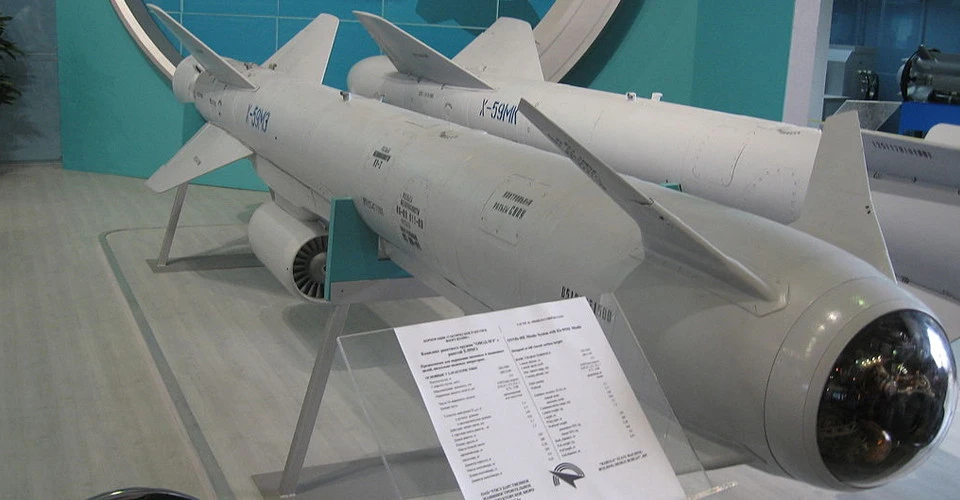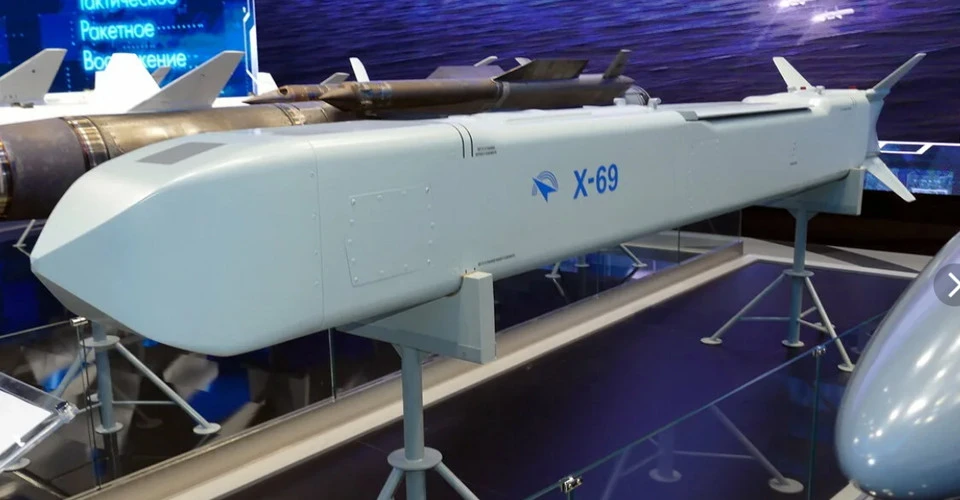
Russian Kh-69 that destroyed Kyiv region's largest thermal power plant: overview and characteristics of missile
On April 11, the Russians launched a massive attack on Ukrainian infrastructure. The Trypilska thermal power plant in the Kyiv region was completely destroyed. Later, it became known Russia had struck the TPP with the latest Kh-69 missiles
Briefly about content of the text:
- What is Kh-69 and how it was created?
- Application in Ukraine
- Technical characteristics of the Kh-69 missile
- What are Kh-69 missile features?
- What is a Kh-69 missile's danger?
- How Ukraine can counteract Kh-69 missiles
What is Kh-69 and how it was created?
The Kh-69 is a Russian precision-guided, low-observable air-to-surface cruise missile designed to target stationary ground objects with known coordinates prior to launch, including those lacking radar, infrared, or optical contrast against the background.
Developed by the Moscow-based design bureau MKB Raduga, located in Dubna, Moscow region, the bureau has faced sanctions from most Western countries following Russia's full-scale invasion of Ukraine.
The Kh-69 was first publicly showcased in August 2022, earning it a reputation as one of Russia's latest developments. However, experts emphasize that this missile is a modification of the Kh-59MK2, which, in turn, is an upgrade of the Kh-59 missile adopted in the early 1980s. The portal Militarnyi reported in 2009 that the Kh-69 was presented as the Kh-59MK2. Setting it apart from its predecessor (the Kh-59MK), the new version incorporated a guidance system likely borrowed from the Kh-555. This combination features an autonomous inertial navigation system with course correction using GLONASS satellite data and an optical-electronic self-guidance system, with sensors orienting based on a map stored in the missile's memory.

Photo: Wikipedia
Significant modifications were made to the missile in 2015. While the guidance system remained unchanged, the turbojet engine was relocated inside the missile's body (previously it was externally suspended). The missile's appearance also changed: they became square-shaped in cross-section, with a pair of retractable wings at the top and fins at the rear that deploy during flight. Russians claimed the missile's warhead weighs 310 kg, with a maximum range of 290 km. The development of the Kh-69 was prolonged but accelerated due to the full-scale Russia-Ukraine war, during which the Kremlin required long-range precision weaponry.
According to the London-based International Institute for Strategic Studies (IISS), in September 2023, Kh-69 missiles were still undergoing flight tests. However, by early 2024, Russia had already used this weaponry to strike Ukraine.
Application in Ukraine
The first known case of using the Kh-69 missile was on February 7, 2024, during a massive missile attack. The Ukrainian public service WarMonitorUa reported that on February 7-8, the Russians fired three Kh-59 and three Kh-69 guided missiles at Mykolaiv, Poltava, and Sumy regions. Five of the six missiles were shot down, and the missile parts and debris were sent to the Kyiv Scientific Research Institute of Forensic Expertise for examination.
The experts of the Kyiv Scientific Research Institute of Forensic Expertise analyzed the materials of the body, as well as a specific foil placed under the outer skin of the warhead. It is likely to lead to an aerial detonation of the missile when it hits the warhead, explained Oleksandr Ruvin, Director of the Institute. He also noted that the markings indicate that the missiles were manufactured in late 2023.

Photo: kndise.gov.ua
Another strike with a Kh-69 missile was launched by the Russians on February 18, 2024. A Su-57 fighter jet launched a missile attack on Ukrainian targets, but the missile missed its target and fell into the open. The Russians likely used the latest Su-57s to launch a missile attack on Ukraine in order to make a military propaganda film against the backdrop of the presidential elections in Russia.
The most recent use of the Kh-69 was on April 11, 2024. The Russians launched a massive air attack on the territory of Ukraine, using several groups of drones, missiles from strategic bombers, ballistic missiles, and daggers. A total of 82 air- and ground-launched missiles were used. It was on this day that the Kh-69 cruise missiles destroyed all the facilities of the Trypillia thermal power plant in the Kyiv region.

Consequences of the destruction of the Trypillia thermal power plant by Russians, Photo: Getty Images
By the way, the April strike allowed for a new assessment of some of the missile's parameters. Previously, the range of the Kh-69 was estimated at 290-300 km, but now, given the distance from the thermal power plant to the line of contact, it is about 400 km, Serhiy Zgurets, Defense Express CEO, said on the Espreso TV channel.
"In fact, this is a subsonic cruise missile that was fired from Russian aircraft. This suggests that the enemy has increased its arsenal of means of striking Ukrainian targets," noted Zgurets.
Technical characteristics of the Kh-69 missile
- The length is 4.2 meters,
- The width and height in the stowed position are 0.4 m,
- Wingspan - 2.45 m,
- The declared flight range is 290 km,
- Probable range - up to 400 km,
- Missile weight - 710 kg,
- Warhead - 310 kg,
- Maximum deviation - 5 m,
- Speed - 700-1000 km/h,
- Flight altitude - 25-70 m.
What are Kh-69 missile features?
The missile is part of the weapon system of the Russian fifth-generation Su-57 fighter jet. However, there are few such aircraft in Russia (according to Defense Express, about a dozen), so the Kh-69 had to be adapted to simpler aircraft. The manufacturers claim that the missile can also be used with Su-30MK, Su-34, Su-35S, MiG-35S, and MiG-29K.
The Kh-69 targets are objects with known coordinates. These can include communications facilities, railway stations, ammunition depots and command posts, oil refineries and petrochemical plants, workshops, and so on.
The warhead of the Kh-69 missiles is of three types: nuclear-combat, cluster, and high-explosive penetrator. The latter type was apparently used in the shelling of the Trypillia thermal power plant, says military and political observer Oleksandr Kovalenko. He says that the Kh-69 is called stealthy because the missile is protected from electronic warfare systems. This makes it difficult to suppress it with electronic warfare and increases the likelihood of an air defense breakthrough.
"These characteristics, for example, include the fact that it has a low flight altitude. It is approximately 20 meters. At this altitude, it is very difficult for radar (counter-battery radar) to detect and track the target. Due to this, the missile can pass through the echeloned air defense along the appropriate trajectories and routes and not even be noticed," Kovalenko said.
Another expert, Mykhailo Samus, deputy director of the Center for Army, Conversion and Disarmament Studies, says that with the Kh-69 missile, the Russians are trying to copy Storm Shadow or Taurus.
"The Russians have managed to modernize this missile, which is very similar visually to the same Storm Shadow or Taurus that the Russians are trying to copy. The problem is that the Russians have been conducting reconnaissance for a long time. These missile launches, the Shahed launches - obviously, they are exposing our radar field before they strike with missiles. This is a new threat that we will have to deal with somehow," the expert noted.
What is a Kh-69 missile's danger?
If we compare the Kh-69 with the Taurus or Storm Shadow, with which the missile has a visual resemblance due to its "parallelepiped shape," the Western missiles have a longer range and are also larger. The payload of Storm Shadow/SCALP is one and a half times larger than that of the Kh-69.
It is worth remembering that although the missiles were developed for the latest Su-57, they can also be launched from Su-34 or Su-35, which Russia has been widely using in the war against Ukraine, striking at Ukrainian frontline positions. Russia has a lot of these aircraft, so attacks with Kh-69 missiles can be massive and (if the range of 400 kilometers is confirmed) will threaten most of Ukraine.
"If the Kh-101 is used from strategic bombers and the preliminary launch time can be determined, then a significant number of Su-35s (provided that the Kh-69 is produced more massively) creates a greater opportunity for the enemy to use these cruise missiles," explained Serhiy Zgurets, director of the Defense Express information and consulting company, on the Espreso TV channel.
The Defense Express article even suggested that the use of the Kh-69, although subsonic and with a smaller warhead, could be more dangerous for Ukrainians than the hypersonic Kinzhal.

Photo: defence-ua
"First, its effective strike indicates that it can penetrate the exhausted Ukrainian air defense. Secondly, its launch from tactical aircraft eliminates the characteristic feature of large-scale missile attacks, when takeoffs of Tu-95MS and MiG-31K strategic bombers are recorded. Also, its use, precisely due to the launch from Su-34 or Su-35, can be more widespread due to the larger number of carriers. But only after the Russian Federation establishes its full-scale mass production," the article says.
The experts also shared a map showing the area affected by the Kh-69 missiles.
"The map shows only hypothetical launch areas, without taking into account the possibility of the Russian forces using the airspace of Belarus. If the Russian Federation repeats this practice in 2022 from the airspace of its satellite, the entire territory of Ukraine, except for the Zakarpattia region, may be added to the target area," Defense Express emphasized.
How Ukraine can counteract Kh-69 missiles
The Kh-69 is a difficult target for Ukrainian air defense. The missile's ability to fly ultra-low at an altitude of 20 meters is an advantage and a problem for Ukrainian air defense. Another point that complicates the fight against the missiles is the relatively small size of the Kh-69 (4.2 meters, while, say, the Kh-101 has a 7.5-meter length).
Defense Express calls every hit on such an air target an outstanding result of Ukraine's air defense forces. However, analysts emphasize that the strike on the Trypilska TPP on April 11, 2024 "suggests that it can penetrate the obviously depleted Ukrainian air defense."
"Of course, the Kh-69 is a new missile for us. So we are studying how we can counter it. Most likely, the Patriot will also be able to resist it, as it has fought against quite more sophisticated types of missiles, such as Zircon and Kinzhal," said Illia Yevlash, spokesman for the Ukrainian Air Force, after the April 11 attack.
However, the Defense Forces can fight the Kh-69 with more than just Patriots, Zgurets is convinced.
"These cruise missiles are subsonic, they can be shot down even from man-portable air defense systems, from any systems that shoot down Shaheds. The issue is that we need to increase the number of different means to cover our hydroelectric power plants and thermal power plants. This should be done both independently and in cooperation with our partners," the military expert emphasized.
- News













































